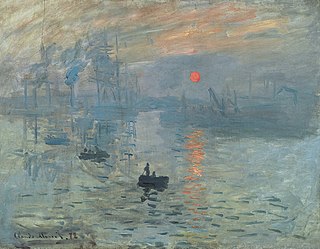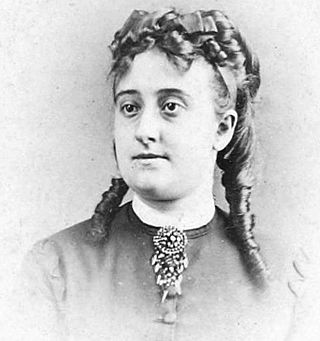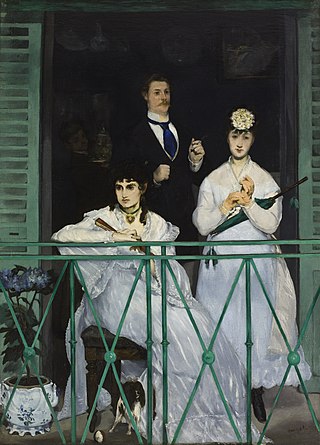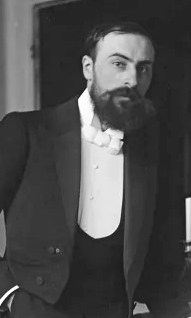
Berthe Marie Pauline Morisot was a French painter and a member of the circle of painters in Paris who became known as the Impressionists.

Édouard Manet was a French modernist painter. He was one of the first 19th-century artists to paint modern life, as well as a pivotal figure in the transition from Realism to Impressionism.

Impressionism was a 19th-century art movement characterized by relatively small, thin, yet visible brush strokes, open composition, emphasis on accurate depiction of light in its changing qualities, ordinary subject matter, unusual visual angles, and inclusion of movement as a crucial element of human perception and experience. Impressionism originated with a group of Paris-based artists whose independent exhibitions brought them to prominence during the 1870s and 1880s.

Suzanne Valadon was a French painter who was born Marie-Clémentine Valadon at Bessines-sur-Gartempe, Haute-Vienne, France. In 1894, Valadon became the first woman painter admitted to the Société Nationale des Beaux-Arts. She was also the mother of painter Maurice Utrillo.

Musée Marmottan Monet is an art museum in Paris, France, dedicated to artist Claude Monet. The collection features over three hundred Impressionist and Post-Impressionist paintings by Claude Monet, including his 1872 Impression, Sunrise. The museum's fame is the result of a donation in 1966 by Michel Monet, Claude's second son and only heir.

Eva Gonzalès was a French Impressionist painter. She was one of the four most notable female Impressionists in the nineteenth century, along with Mary Cassatt (1844–1926), Berthe Morisot (1841–95), and Marie Bracquemond (1840–1916).

Julie Manet Rouart was a French painter, model, diarist, and art collector.

The Balcony is an 1868–69 oil painting by the French painter Édouard Manet. It depicts four figures on a balcony, one of whom is sitting: the painter Berthe Morisot, who married Manet's brother Eugène in 1874. In the centre is the painter Jean Baptiste Antoine Guillemet. On the right is Fanny Claus, a violinist. The fourth figure, partially obscured in the interior's background, is possibly Léon Leenhoff, Manet's son.

Paule Gobillard was a French artist and Post-Impressionist painter who was heavily influenced by the Impressionists. She is the niece of Berthe Morisot and Eugène Manet, the brother of Édouard Manet, who taught her lessons in painting as part of her education upon being orphaned at an early age. She was unknown in the art scene compared to her relatives. She exhibited with the Société des Indépendants in 1904 and in 1926.

Berthe Morisot with a Bouquet of Violets is an 1872 oil painting by Édouard Manet. It depicts fellow painter Berthe Morisot dressed in black mourning dress, with a barely visible bouquet of violets. The painting, sometimes known as Portrait of Berthe Morisot, Berthe Morisot in a black hat or Young woman in a black hat, is in the collection of the Musée d'Orsay in Paris. Manet also created an etching and two lithographs of the same composition.

Summer's Day is an oil-on-canvas painting by the French Impressionist painter Berthe Morisot, created in 1879. The painting depicts two women seated in a row boat, and was painted in the Bois de Boulogne. It is held at the National Gallery, in London.

Edma Morisot was a French artist and the older sister of the Impressionist painter Berthe Morisot.

La Petite Niçoise is an oil-on-canvas painting by the French Impressionist artist Berthe Morisot, executed in 1889. It has been in the collection of the Musée des Beaux-Arts de Lyon since 1907.

Berthe Morisot with a Fan is a painting by French artist Édouard Manet, executed in 1874. It belongs to the collection of the Musée d'Orsay, in Paris, but since 2000 it is in loan to the Palais des Beaux-Arts de Lille.

Eugène Manet on the Isle of Wight is an oil-on-canvas painting by French artist Berthe Morisot. The painting depicts a man, Eugène Manet, relaxing at a hotel window, with vases visible on the parapet. Manet is looking out the window as two elegantly dressed women in white pass by. Several boats appear at the shoreline.

The Cradle is an oil on canvas painting by the French Impressionist painter Berthe Morisot, executed in 1872. It is on display at the Musée d'Orsay in Paris.

The Harbor at Lorient is an oil-on-canvas painting by French artist Berthe Morisot, executed in 1869. The painting has the dimensions of 43 by 72 cm. It is held at the National Gallery of Art, in Washington, D.C.

In a Park is a pastel painting on paper mounted on cardboard, executed c. 1874 by French artist Berthe Morisot. It is held at the Petit Palais in Paris.

Ernest Rouart was a French painter, watercolorist, pastellist, engraver, and art collector.

The Mother and Sister of the Artist, also known as The Reading, is an oil-on-canvas painting by French artist Berthe Morisot, created in 1869–1870. It is exhibited at the National Gallery of Art, in Washington, D.C.




















